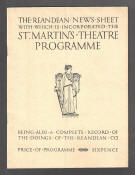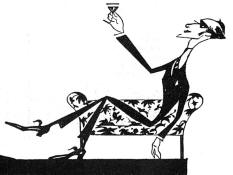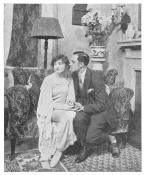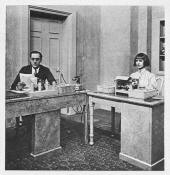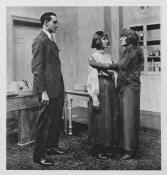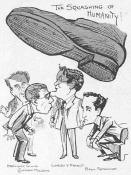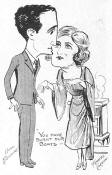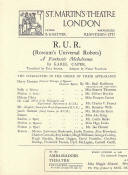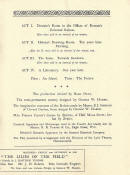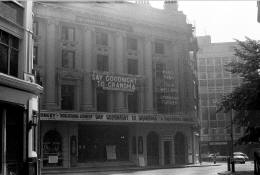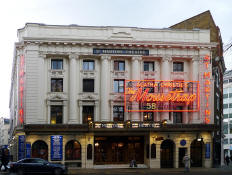R. U. R. A fantastic melodrama by Karel Capek. Translated by Paul Selver, adapted by Nigel Playfair. Opened at St. Martin's Theatre, London, April 24, 1923. After 127 performances, the play closed on August 11, 1923. Produced by Basil Dean. General Manager: E. P. Clift; Deputy Manager: Roger Ould;
Assistant Producer: S. E. Percy; Musical Director: Morton Stephenson; Stage
Manager: A. Bernard Ince; Asst. Stage Managers: Vere Bennett, John F. Barham;
Stage Superintendent: Albert Jones; Engineer: J. Appleford; Property Master: T. Morgan; Assistant Property
Master: W. Drabwell; Electricians: H. McDonnell, Walter Veness; Carpenter: J. Foster; Wardrobe
Mistress: Mrs. F. W. Stock; Box Office Managers: J. W. Clifford Brown, C. Wood; Scenery,
Costume design: George W. Harris; Costumes: B. J. Simmons, Berthe, Zyrot
R. U. R. is a story of the world’s repopulation with artificial beings. The initials R. U. R. stand for Rossum's Universal Robots, a company that manufactures robots by the thousands and ships them all over the world. The robots look exactly like humans, but they have no soul, no feelings. They are being used as laborers, so that human beings will no longer have to toil. Rathbone plays Harry Domain, the manager of the company. Domain predicts:
Could it be that Star Trek creator Gene Roddenberry read R. U. R. and was influenced by it? Roddenberry's vision of the 24th century is a world without poverty, in which people work not to earn money, but to better themselves. ("The acquisition of wealth is no longer the driving force in our lives. We seek to better ourselves and the rest of humanity." —Captain Picard, Star Trek: First Contact) Helena Glory, the daughter of the company's president, visits the factory and talks to some of the robots about how they are treated. She represents the Humanity League, which has two hundred thousand members who are outraged over the slavery of the robots. Helena cannot understand how the robots can put up with it. But they are not impressed. Liberation means nothing to them. In spite of Helena's feelings about the misuse of the robots, she and Harry Domain fall in love and marry. Act II takes place ten years later, and Domain’s predictions have not come true. The governments of different countries have turned the robots into soldiers and taught them to kill humans. There have been many wars and the robots have killed hundreds of thousands of people. Lately the robots have revolted and issued a manifesto: "The first international organization of Rossum's Universal Robots proclaim man as our enemy and an outlaw in the universe. Robots throughout the world, we command you to kill all mankind. Spare no men! Spare no women! Save factories, railways, machinery, mines and raw materials. Destroy the rest!" The robots on the island attack the office and kill all the humans save one. The robots do not know how to produce more robots, and need the human to show them how. Unfortunately for them, the human they spared was an engineer, not one of the scientists who produced robots, so he's unable to help. Also, the document containing the secret of the robots' manufacture was destroyed shortly before the attack. So one year later 8 million robots have "failed" (died) and no new ones have been created. The play ends with two of the newest Robots, Helena and Primus, discovering that they have feelings for each other. So perhaps they'll find another way to reproduce. [The plot summary above is adapted from The Best Plays of 1922-23, ed. by Burns Mantle (Dodd, Mead and Co., 1923), pages 343-382.]
Karel Capek's play premiered in Prague in 1921, and ran for 63 performances. The following year Paul Selver translated the play from Czech into English. The American première was at the Garrick Theatre in New York City on October 9, 1922, where it ran for 184 performances. London playgoers first saw R. U. R. at St. Martin's Theatre on April 24th, 1923. The production ran for 126 performances in London and then went on tour throughout England. Basil Rathbone was part of the London cast only, and did not go on tour with R. U. R. When the play closed on August 11, 1923, Rathbone left London and returned to New York. He had a leading role in The Swan when that play opened in October 1923. Based on a conflict between human heroes and robots, R. U. R. was translated into 30 languages and produced in Berlin, Warsaw, Riga, Paris, London, Moscow, and New York. R. U. R. is known for having introduced the word "Robot" into the language. The word is derived from a Czech word that means both worker and serf or peasant. The Robots in the play are mass-produced workers. In 1926, the play was adapted for radio and broadcast on the BBC Radio.
"Three major threads underlie RUR: first, the response to the tremendous loss of life during the First World War as a result of technology; second, the debate between capitalism and communism about labour and the ideal society; and, finally, the desire to usurp God by creating life. The atrocities of the First World War made the concept of Robot soldiers particularly provocative for theatre audiences who had just survived a war with nine million deaths and millions more wounded. Everyone in the audience would have known someone who died as a result of the war and the idea of robot replacements for soldiers would have been compelling. The First World War was the bloodiest war up to that point in history. It was a war full of new technologies: tanks, grenades, mortar bombs, machine guns, poison mustard gas, and zeppelins. Battle photographs captured the visceral images of the wounded and the dead, bringing them directly into people's homes via newspaper, also for the first time. Past wars had been visually recorded as paintings, drawing, woodcuts, etchings, or even daguerreotypes, none of which could capture the brutality of war with the same intensity as a photograph. All of these new technologies made people suddenly aware of the very real possibility of the destruction of the human race by its own machine-based creations." —K. Reilly, Automata and Mimesis on the Stage of Theatre History, 2011
The critics praised Basil Rathbone's performance as the company manager, Harry Domain. Some of Rathbone's fellow cast members were familiar to him:
A trivia tidbit: Beatrix Thomson, who played Sulla in R. U. R. (see photos above), married Claude Rains in 1924; they remained married until 1935. Claude played Prince John in The Adventures of Robin Hood.
"There is one 'gripping' moment, when the Robots come to exterminate the last four human beings left on earth. Besides this moment, the horror lies more in the dramatist's idea than in the dramatic action of his play. But the play is also an allegory of the human race. The Robots are but the workers, whom the employers have given the chance of education — and in giving them that chance have made them discontented, ambitious, finally, more powerful than the employers themselves. And the moral is that you cannot keep a man a 'Robot' if you give him leisure to cultivate his intelligence. Only the ignorant and savage are contented by their lot. Some people will read into the author's intention another significance. That is the interest of his play. It makes one think." —Arkay, The Tatler, May 16, 1923 "The much-heralded Czech play, R.U.R., adapted from Karel Capek by Nigel Playfair, and produced by Basil Dean at the St. Martin's, proved an interesting and thrilling affair. It is frankly described as a 'fantastic melodrama,' and the dullest playgoer could not but be interested in the manner of the Robots' manufacture and their terrific, overwhelming revenge on humanity." —The People, April 29, 1923 "Mr. Basil Dean's production, as always, is arresting and provocative. The general stage pictures are good, especially the backcloth of the Robot factory. ... The Robots are well dressed, well drilled, well acted (notably by Mr. Leslie Banks, who can grip his audience as quickly as any actor of our stage). ... The use of siren-blasts is weird and wonderful, and induces the needful touch of hysteria. The human actors are not so successfully produced." —Ashley Dukes, The Illustrated Sporting and Dramatic News, May 5, 1923 Two drawings from The Illustrated Sporting and Dramatic News, May 26, 1923:
"An exciting, thrilling play, which everyone will enjoy. ... Mr. Basil Rathbone looked very handsome as Harry Domain, but acted stiffly." —The Spectator, May 5, 1923 "Mr. Basil Rathbone did very pleasantly and manfully. ... No one should miss this most interesting play." —James Agate, The Saturday Review, May 5, 1923 "The London first-night audience was roused to a great pitch of enthusiasm over the play and prolonged the applause at the final curtain. The critics describe the piece as a genuine thriller which will set London talking and much praise is bestowed on the acting, especially that of Miss Frances Carson, who plays the role of Helena Glory." —The New York Times, April 29, 1923 "Mr. Leslie Banks as a Robot of unusual stature and uncomfortable intelligence was one of the greatest successes of the evening. Other honours went to Mr. Basil Rathbone." —The Westminster Gazette, April 25, 1923
"Here is our old friend Frankenstein and the monster, stripped of nearly all the horror, and cleverly brought up to date—a perfectly engrossing play, giving you furiously to think. It has been endowed by the genius of Basil Dean, with a suggestive scenic surrounding. ... Mr. Basil Rathbone's the manager, Miss Frances Carson as his eventual wife, and Mr. C. V. France as the scientific director, were curiously well chosen and efficient." —The Era, May 2, 1923 "The parts of Domain, Gall, and Berman, mere pale, ineffectual mortals, and with sympathy diverted by Capek from them to the machines, all gave excellent opportunities for good acting to Messrs. Basil Rathbone, Charles V. France, and Clifford Mollison." —The Stage, April 26, 1923 "Mr. Dean has bestowed upon the play the fanciful setting it demands—the view of the factory where human automatons are made is as eerie as the theme; the acting calls for unstinted praise; the sincerity of Basil Rathbone, of C. V. France, of Ada King, of Frances Carson (whose every step means advance), carries us away." —The Sketch, May 9, 1923 Pages from inside the programme:
"Capek has written an extraordinarily good melodrama, and cleverly touched it up so that it will make an appeal to the highbrow person with a soul above melodrama." —The Midland Daily Telegraph, April 26, 1923 "It is a remarkable play, skilfully interpreted by such artists as Mr. Basil Rathbone, Mr. Gilbert Ritchie, Miss Frances Carson, Mr. C. V. France, Mr. Brember Wills, Mr. Clifford Mollison, Miss Ada King, Mr. Leslie Banks, Miss Olia Lindo, and Mr. Ian Hunter, and it had an enthusiastic reception." —The Scotsman, April 26, 1923 "R.U.R., at the St. Martins, is an outstanding play. It provides both a tense emotional and dramatic atmosphere and an appeal to the intellect. Karel Capek's patriotism of mankind, his passionate grief at the idea that man might perish, leads one to a further question: Would it matter? A fine play, finely acted." —M. E., The Daily Herald, April 25, 1923
. |
|||||||||||||||||||||||||||||||||||||||||||||||||||||







